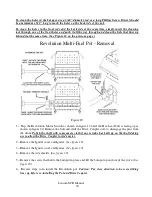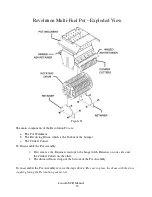
Lincoln SCR Manual
29
CAUTION: Operate this unit only with the fuel hopper lid closed. Failure to do so may result in
emission of products of combustion from the hopper under certain conditions. Maintain hopper
seal in good condition. Hopper lid switch will prevent the auger from running if lid is left open.
This unit requires 120-volt AC power to operate. In the event of a power failure the unit will shut
down.
DO NOT ATTEMPT TO RUN THE UNIT DURING A POWER FAILURE.
INSTALLATION CHECK
Proper installation is essential for safety, effective Operation, Warranty Coverage, Insurance
requirements and to meet Local Building Codes. Installation Requirements are described in the first
section of this manual. Verify the installation is correct before firing up the Stove for the first time.
When burning Corn, Wheat, Rye or Distiller’s Grain, care should be taken in how the venting system
is installed. To burn these fuels the moisture content should be 15% or less. This is much higher than
the moisture content of wood pellets and can result in condensation forming in the venting system in
certain installations. The chimney system should stay within the warm envelope of the house as much
as possible. Only penetrate the exterior of the home where the exhaust system will terminate.
REMEMBER: Condensation from a corn Stove is detrimental to the venting system. Only buy
venting systems that are warranted with burning corn.
PREVENTING CHIMNEY FIRES
Chimney fires can be prevented by properly operating the Stove and by periodic inspection and
cleaning of the chimney. When wood is burned it produces tar and other organic vapors, which
combine with expelled moisture to form creosote. The creosote vapors condense in the relatively cool
chimney flue associated with a slow burning fire. As a result, creosote residue accumulates on the flue
lining. When ignited this creosote can result in an extremely hot chimney fire.
The chimney and chimney connector should be inspected at least once every two months during the
heating season to determine if a creosote build-up has occurred. If a significant layer of creosote has
accumulated (3 mm or more) it should be removed to reduce the risk of a chimney fire. Use of an
appropriately sized chimney brush or the services of a professional chimney sweep are recommended.
The chimney and chimney connector should be inspected at least once every two months during the
heating season to prevent the system from getting plugged with fly ash. Clean the exhaust system if
needed. Use of an appropriately sized chimney brush or the services of a professional chimney sweep
are recommended.
LINCOLN SCR OPERATION
















































